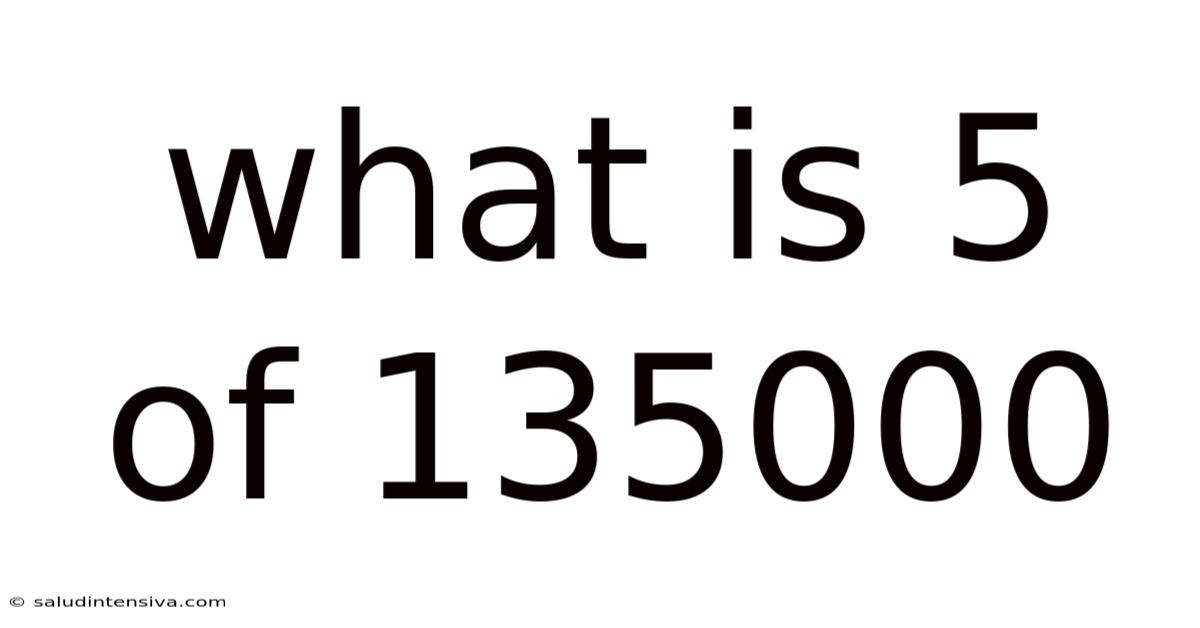What Is 5 Of 135000
saludintensiva
Sep 25, 2025 · 5 min read

Table of Contents
What is 5/135000? Understanding Fractions and Their Applications
This article explores the seemingly simple question: "What is 5/135000?" While the calculation itself is straightforward, understanding the process reveals fundamental concepts in mathematics, particularly fractions and their real-world applications. We will delve into how to solve this fraction, explore different methods for simplification, and discuss scenarios where such calculations are relevant. This comprehensive guide is designed for anyone, from students grasping basic arithmetic to professionals needing a refresher on fractional calculations.
Understanding Fractions: A Quick Refresher
Before diving into the calculation, let's revisit the basics of fractions. A fraction represents a part of a whole. It consists of two parts:
- Numerator: The top number, representing the number of parts you have.
- Denominator: The bottom number, representing the total number of parts the whole is divided into.
In our case, 5/135000, 5 is the numerator and 135000 is the denominator. This means we are considering 5 parts out of a total of 135000 equal parts.
Calculating 5/135000: Step-by-Step
The simplest way to find the value of 5/135000 is through division. We divide the numerator (5) by the denominator (135000):
5 ÷ 135000 = 0.000037037...
This decimal representation shows the fraction's value. However, this decimal continues infinitely. For practical purposes, we often round the decimal to a certain number of decimal places. Rounding to six decimal places, we get 0.000037.
Simplifying Fractions: Finding the Greatest Common Divisor (GCD)
While the above method provides a numerical answer, simplifying the fraction can lead to a more manageable and understandable representation. Simplifying involves finding the greatest common divisor (GCD) of the numerator and denominator and dividing both by it. The GCD is the largest number that divides both the numerator and the denominator without leaving a remainder.
In this case, the GCD of 5 and 135000 is 5. Dividing both the numerator and the denominator by 5, we get:
5 ÷ 5 = 1 135000 ÷ 5 = 27000
Therefore, the simplified fraction is 1/27000. This simplified fraction is equivalent to 5/135000, but it is easier to understand and work with.
Different Methods for Simplification
Beyond the GCD method, other techniques can simplify fractions. For instance, if you notice common factors between the numerator and denominator, you can divide them out iteratively. Let's consider the original fraction 5/135000:
- We know that both 5 and 135000 are divisible by 5. Dividing both by 5 gives us 1/27000.
- Further simplification isn't possible as 1 and 27000 share no common factors other than 1.
Real-World Applications of Fractional Calculations
Fractions are ubiquitous in everyday life and across various disciplines. Here are some examples where calculations similar to 5/135000 might be relevant:
-
Probability and Statistics: Imagine a lottery with 135,000 tickets. The probability of winning with one ticket is 1/135000. If you buy five tickets, your probability increases to 5/135000, which simplifies to 1/27000. This illustrates how fractions are used to express probabilities.
-
Engineering and Physics: In engineering designs or scientific experiments, extremely small quantities are often expressed as fractions. For example, a tiny change in pressure or a minute amount of a chemical substance might be represented using very small fractions.
-
Finance and Accounting: Fractional calculations are essential in finance for calculating percentages, interest rates, and proportions of investments. A small portion of a large investment might be represented by a fraction.
-
Data Analysis: When dealing with large datasets, expressing small proportions of the data as fractions helps to understand the relative contribution of different parts.
-
Manufacturing and Quality Control: In quality control processes, the fraction of defective products in a large batch can be expressed as a fraction, helping to assess the overall quality.
Understanding Percentages
Often, it's helpful to express a fraction as a percentage. A percentage is a fraction where the denominator is 100. To convert 5/135000 to a percentage, we can first simplify it to 1/27000 and then perform the calculation:
(1/27000) * 100% ≈ 0.0037%
This indicates that 5 out of 135000 represents a very small percentage, approximately 0.0037%.
Frequently Asked Questions (FAQ)
Q1: Can I use a calculator to solve this fraction?
A1: Absolutely! Most calculators can directly compute 5 ÷ 135000. However, understanding the manual steps is crucial for a deeper comprehension of the underlying principles.
Q2: What if the numerator was a larger number?
A2: The process remains the same. You would still divide the numerator by the denominator. The complexity might increase if simplification is required, especially if dealing with large numbers, but the fundamental approach remains unchanged.
Q3: Are there any online tools to simplify fractions?
A3: Yes, many websites and apps provide fraction simplification tools. However, the manual method is important for developing mathematical skills and understanding the process.
Q4: What if the denominator was zero?
A4: Dividing by zero is undefined in mathematics. It leads to an error. If you encounter such a scenario, review your problem setup.
Conclusion
Calculating 5/135000 involves straightforward division, resulting in a decimal value approximately equal to 0.000037. However, simplifying the fraction to 1/27000 provides a more easily understandable representation. This simple calculation highlights the fundamental concepts of fractions, their simplification, and their wide-ranging applications in various fields. Understanding fractions is a building block for more advanced mathematical concepts, emphasizing the importance of grasping these fundamental principles. Mastering these techniques allows for a deeper understanding of data, probabilities, proportions, and many other critical aspects of daily life and various professional fields.
Latest Posts
Related Post
Thank you for visiting our website which covers about What Is 5 Of 135000 . We hope the information provided has been useful to you. Feel free to contact us if you have any questions or need further assistance. See you next time and don't miss to bookmark.